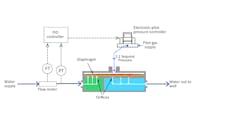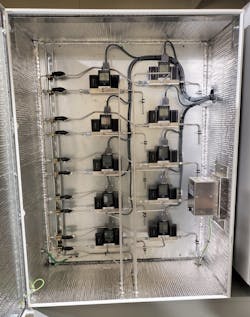Case Study: New flow control valve addresses demanding oil well injection application
Modern fluid control applications involve increasingly demanding requirements, including extremely low or extremely high differential pressure (DP), wide flow coefficient ranges, multiphase flow or supercritical states. To meet these demands, engineers must often rethink designs, and their choice of flow control valve is key to success. Popular options include rising stem globe-style valves, rotating ball valves and slide gates. Each of these valve types are offered with variants for extreme pressure, extreme temperatures and chemical resistance. They also come in a variety of flow ranges.
A new type of flow control valve
A new type of flow control valve is becoming known for its effectiveness, especially for dosing and injection applications. Direct-sealing diaphragm valves with dome-loaded actuation, which have been used to control back pressure for more than 10 years, are being adapted for use as flow control valves. They are especially well-suited for processes requiring wide flow range, high precision, two-phase flow and other specific demands. These valves are often a good choice for problems that cannot be solved by traditional methods.
Oil well injection application
Intermountain Electronics (IE), a provider of custom engineered solutions for the upstream and midstream petroleum industry headquartered in Utah, was retained by a large energy company to design a multi-well automated water injection system. The dosing system was needed to inject water at the base of oil wells in the Bakken Basin of North Dakota to prevent produced salt from crystallizing inside the wellhead. Salt buildup in the wells had been occurring as crude oil was brought to the surface, resulting in maintenance issues with surface equipment and downtime for the oil field.
Careful dosing of the water in this situation was important because it required a delicate balance of having just enough water to prevent crystallization, but not much more. Any water in excess of minimum requirements would increase the volume needing to be treated, transported or re-injected into the ground via saltwater disposal wells; all of which affect oil production economics. Water used in this type of oil well injection process must be handled carefully due to environmental regulations.
This oil well injection system was a difficult application because oil well pressure is extremely variable, and the flow requirements vary significantly from well to well. Required water injection flow rates varied through a 50:1 range. Available pressure drop varied through a 22:1 range. The resulting valve coefficient (Cv) needed for these dosing skids ranged through a 230:1 ratio, exceeding typical control valve capabilities.
In phase one of the dosing system design, standard globe-style control valves were used to control flow through each injection line. The globe valves alone, however, did not have the capacity to meet the 230:1 Cv range required for controlling the various flows in the application. The IE engineers coupled direct-sealing diaphragm back-pressure valves in line with the globe valves to extend their flow control range, resulting in a dosing system meeting the demanding requirement. Twenty dosing skids covering freshwater injection to 127 oil wells were successfully deployed during phase one of the field implementation using this passive back-pressure valve technique.
Phase two: Streamlining the design
During phase two of the design development, it was proposed that the direct-sealing diaphragm valves be used as the active flow control valves, rather than in the role of passive back-pressure valves. Because these valves had been used for flow control in the past, the engineers were optimistic that it could be done. This solution would eliminate the need for the globe-style control valves altogether, streamlining the design and reducing the cost for each skid.The direct-sealing diaphragm valve uses multiple orifices and pneumatic pilot pressure set point on top of the diaphragm to create precise control across a wide range of flow. An electronic pilot pressure controller communicates with a proportional-integral-derivative (PID) controller to deliver the appropriate pneumatic set point to the diaphragm valve. It can work equally well in a pressure control loop or a flow control loop.
A couple modifications to the phase one process were made to enable the direct-sealing diaphragm valve to operate in flow control rather than back pressure control.
A PID controller still monitored the flow from a flow transmitter, but this time, it adjusted the pilot pressure on the direct-sealing diaphragm valve to bring the flow under control. In this configuration, flow is decreased by raising the pilot pressure and, conversely, flow is increased by lowering the pilot pressure.
The PID controller was switched to direct mode instead of the more common inverse mode, because with this new valve, pressure must be increased in response to an increase in flow. This is the reverse response of the globe-style flow control valve.
After those minor adjustments, the phase two system worked smoothly, and extensive tests proved it could deliver the required Cv range for the oil field application. IE proposed the new system to their large energy customer and won the contract for phase two. The phase two system design was not only streamlined and less expensive, but it also covered a wider Cv range than the phase one design.
Considering pilot pressure control
Pilot pressure controllers require a pressurized gas supply to operate. For the injection skids, IE designed and installed an integral high-pressure air amplifier system for the pilot gas supply.
Conclusion
Traditional flow control valves serve engineers well in many designs, but in applications that require wider Cv range, higher precision, multiphase fluid control or other complex elements, a direct-sealing diaphragm valve offers advantages that should be considered.
Diane Jacober, M.Eng., is a technical content creator and mechanical engineer for Equilibar, LLC, which designs and manufactures direct-sealing diaphragm valves near Asheville, North Carolina. She has worked as a process engineer, project engineer and technical marketing specialist for several companies in a variety of fields. Jacober may be reached at [email protected]. For more information, visit equilibar.com.
Christopher Duffield is head of Test & Integration at Intermountain Electronics (IE) facility in Denver, Colorado, and he is the site expert on process and automation. Duffield has been intimately involved in the engineering and manufacturing of freshwater injection skids from initial concept to current implementation and has worked closely with Equilibar to ensure that phase two of the design was an operational success. He may be reached at [email protected].
Diane Jacober
Diane Jacober, M.Eng., is a technical content creator and mechanical engineer for Equilibar, LLC, which designs and manufactures direct-sealing diaphragm valves near Asheville, North Carolina. She has worked as a process engineer, project engineer and technical marketing specialist for several companies in a variety of fields. Jacober may be reached at [email protected]. For more information, visit equilibar.com.
Christopher Duffield
Christopher Duffield is head of Test & Integration at Intermountain Electronics (IE) facility in Denver, Colorado, and he is the site expert on process and automation. Duffield has been intimately involved in the engineering and manufacturing of freshwater injection skids from initial concept to current implementation and has worked closely with Equilibar to ensure that phase two of the design was an operational success. He may be reached at [email protected].




